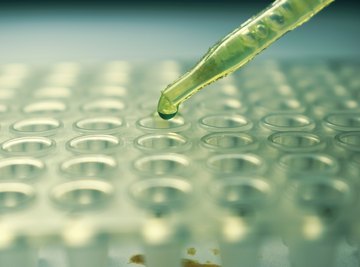
Starches are carbohydrates contain a large number of glucose molecules that are bound together. These simple glucose sugars can be separated from one another using an acid like hydrochloric acid. To observe the process of starch hydrolysis using hydrochloric acid, you'll need to observe the amount of simple sugars that are in a sample of starch that is subject to hydrochloric acid compared to a sample of starch that does not interact with the acid.
- Protective gloves
- Safety goggles
- Beaker
- Bunsen burner or other heat source
- Water
- Pipette
- 2 test tubes
- Starch solution
- Benedict's reagent
- Test tube tongs
- Hydrochloric acid
- Sodium bicarbonate solids
Put on protective gloves and safety goggles.
Add water to a beaker until it is partially full. Heat the water on a Bunsen burner or other heat source until it reaches the point of boiling. Once you've reached the boiling point, reduce the heat slightly to keep the water boiling.
Add a small amount of starch solution to a test tube via a pipette.
Rinse the pipette and add a small amount of Benedict's reagent to the starch solution. Benedict's reagent is a solution of copper sulfate and sodium hydroxide that is used to detect the level of sugars in a solution.
Place the test tube into the beaker of boiling water. Allow the test tube to boil for five minutes.
Add a small amount of starch solution and Benedict's reagant to a second test tube. Then rinse the pipette and add a small amount of hydrochloric acid to the second test tube.
Place the second test tube into the beaker of boiling water. Allow the test tube to boil for five minutes.
Remove the test tubes from the beaker using test tube tongs. Place the test tubes on a test tube cooling rack.
Neutralize the acid in the second test tube using sodium bicarbonate. Slowly add chunks of solid sodium bicarbonate to the test tube until the solution ceases fizzing.
Allow the test tubes to cool off until they can be handled easily.
Observe the color of each test tube, which corresponds to the amount of sugar present in the solution. The second test tube will be more dark red or brown, indicating that the hydrochloric acid hydrolyzed the starch in the solution and produced greater quantities of simple sugars.
Things You'll Need
References
About the Author
Dan Howard is a sports and fitness aficionado who holds a master's degree in psychology. Howard's postgraduate research on the brain and learning has appeared in several academic books and peer-reviewed psychology journals.
